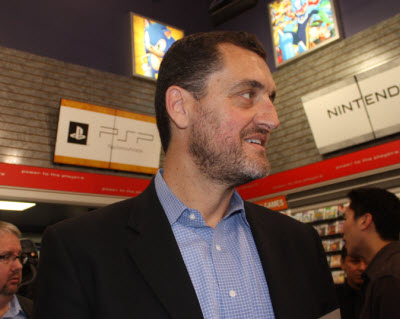GameStop said that revenues for its fourth quarter ended January 28 dropped 13.6 percent to $3.05 billion, while net income was down 18 percent to $208.7 million. On an adjusted basis, earnings were $243.8 million, down 3 percent from a year ago. Those earnings were below analysts’ expectations.
The world’s biggest game retail store operator said that overall video game sales were weak, particularly as the consoles show their age. But non-gaming businesses helped stabilize the company’s financial picture. GameStop’s fourth quarter GAAP net earnings were $208.7 million, or $2.04 per diluted share, compared to net earnings of $247.8 million, or $2.36 per diluted share in the prior-year quarter.
Please check out our GamesBeat Summit 2017 event coming May 1-2. Use Deantak code for 20 percent off.
Paul Raines, chief executive officer, said in a statement, “GameStop’s transformation continued to take hold in 2016, as our non-gaming businesses drove gross margin expansion and significantly contributed to our profits. Meanwhile, the video game category was weak, particularly in the back half of 2016, as the console cycle ages. Looking at 2017, Technology Brands and Collectibles are expected to generate another year of strong growth, and new hardware innovation in the video game category looks promising. As we continue our transformation plan, we will also be focused on managing (sales and administrative) spend, rationalizing our global store portfolio, and maximizing free cash flow generation to drive shareholder value.”
Consolidated comparable store sales declined 16.3 percent (down 20.8 percent in the U.S. and down 4.6 percent internationally). As stated in the company’s holiday sales release in January, the fourth quarter was significantly impacted by weak sales of certain Triple-A titles and aggressive console promotions by other retailers on Thanksgiving Day and Black Friday. As a result, new hardware sales declined 29.1 percent and new software sales declined by 19.3 percent. Pre-owned sales outperformed new video games, declining 6.7 percent compared to the fourth quarter of 2015.
In general, digital sales competitors are also eating into retail sales of games. Non-GAAP digital receipts declined 7.7 percent, to $373.4 million and GAAP digital sales declined 5.8 percent, to $57.2 million. Digital sales were impacted by the decline in new video game sales.

Above: Paul Raines of GameStop
Technology Brands sales, which are not included in comparable store sales, increased 43.9 percent to $256 million, primarily driven by year-over-year store growth. Technology Brands adjusted operating earnings were $34 million, an 88.9 percent increase compared to $18 million in the prior-year quarter. On a GAAP basis, operating losses were $12 million due to store rationalization and asset impairment charges recorded during the fourth quarter.
Collectibles sales rose 27.8 percent to $212.4 million, driven by strong sales of Pokémon-related toys and apparel. The company added 17 Collectibles stores during the quarter, bringing the total global portfolio to 86 stores, including 24 ThinkGeek stores in the U.S.
The fourth quarter results include charges of $56.5 million ($35.1 million, net of tax), or $0.34 per diluted share. These charges are primarily related to store rationalization and asset impairments to optimize the Technology Brands store portfolio after four years of rapid expansion. Additionally, the quarter and the full year were positively impacted by a $27.3 million tax benefit related to international tax planning efforts.
Excluding these charges, GameStop’s adjusted net earnings for the fourth quarter were $243.8 million, compared to adjusted net earnings of $251.6 million in the prior-year quarter. Adjusted diluted earnings per share were $2.38 compared to adjusted diluted earnings per share of $2.40 in the prior-year quarter.
For the full fiscal year ended January 28, GameStop reported sales of $8.61 billion, down 8.1 percent, while comparable store sales were down 11 percent.
Technology Brands achieved the goal of delivering between $85 million and $100 million of adjusted operating earnings in fiscal 2016 as it contributed $90.2 million for the year, a 216.4 percent increase over 2015. On a GAAP basis, operating earnings increased 63.7 percent from $27.0 million to $44.2 million.
The Collectibles business achieved the high end of its $450 to $500 million revenue target, as sales increased 59.5 percent to $494.1 million in fiscal 2016. Gross margin percentage was at 35 percent.
Non-physical gaming businesses comprised 36.9 percent of the company’s total adjusted operating earnings in fiscal 2016 compared to 24.5 percent in fiscal 2015.
Non-GAAP digital receipts grew 4 percent to $1.1 billion. GAAP digital revenue declined 3.9 percent to $181.0 million. GameStop’s fiscal 2016 GAAP net earnings were $353.2 million, including $60.6 million ($37.7 million, net of tax) of charges related to store closings and asset impairments. This compared to net earnings of $402.8 million in fiscal 2015. Diluted earnings per share were $3.40, compared to diluted earnings per share of $3.78 in fiscal 2015.
Excluding these charges, GameStop’s adjusted net earnings for the full year were $390.9 million, or $3.77 per diluted share, compared to adjusted net earnings of $415.6 million, or $3.90 per diluted share, in fiscal 2015.
Rob Lloyd, GameStop chief financial officer, said in a statement, “Going forward, GameStop will provide annual guidance, and no longer provide quarterly earnings per share or same store sales guidance. We believe that providing only annual guidance will reduce investor distraction as we continue to diversify the company and seek to maximize long-term shareholder value. It also benefits our organization in that it concentrates attention on longer-term targets and reduces the focus on short-term results, which can be volatile given the current business environment.”
For 2017, GameStop anticipates sales will be in the range of down 2 percent to up 2 percent. Comparable store sales are expected to be down 5 percent, and net income is expected to be $320 million to $354 million.
In 2017, the company anticipates that it will open approximately 35 new Collectibles stores globally, and approximately 65 new Technology Brand stores. The company also anticipates that it will close between 2 percent to 3 percent of its global stores.

